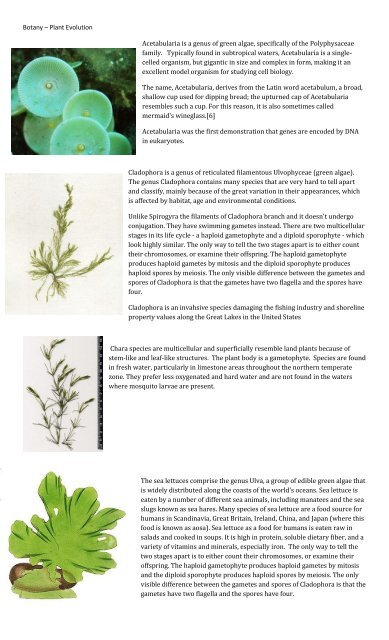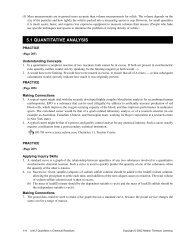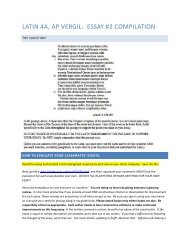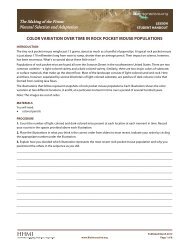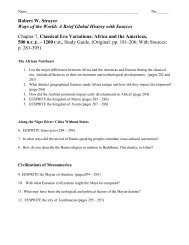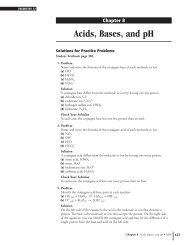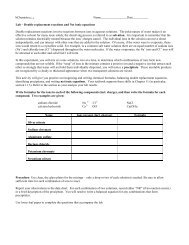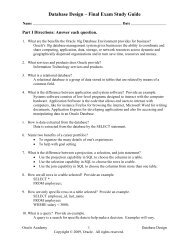Botany – Plant Evolution Acetabularia is a genus of green ... - Quia
Botany – Plant Evolution Acetabularia is a genus of green ... - Quia
Botany – Plant Evolution Acetabularia is a genus of green ... - Quia
Create successful ePaper yourself
Turn your PDF publications into a flip-book with our unique Google optimized e-Paper software.
<strong>Botany</strong> <strong>–</strong> <strong>Plant</strong> <strong>Evolution</strong><br />
<strong>Acetabularia</strong> <strong>is</strong> a <strong>genus</strong> <strong>of</strong> <strong>green</strong> algae, specifically <strong>of</strong> the Polyphysaceae<br />
family. Typically found in subtropical waters, <strong>Acetabularia</strong> <strong>is</strong> a singlecelled<br />
organ<strong>is</strong>m, but gigantic in size and complex in form, making it an<br />
excellent model organ<strong>is</strong>m for studying cell biology.<br />
The name, <strong>Acetabularia</strong>, derives from the Latin word acetabulum, a broad,<br />
shallow cup used for dipping bread; the upturned cap <strong>of</strong> <strong>Acetabularia</strong><br />
resembles such a cup. For th<strong>is</strong> reason, it <strong>is</strong> also sometimes called<br />
mermaid's wineglass.[6]<br />
<strong>Acetabularia</strong> was the first demonstration that genes are encoded by DNA<br />
in eukaryotes.<br />
Cladophora <strong>is</strong> a <strong>genus</strong> <strong>of</strong> reticulated filamentous Ulvophyceae (<strong>green</strong> algae).<br />
The <strong>genus</strong> Cladophora contains many species that are very hard to tell apart<br />
and classify, mainly because <strong>of</strong> the great variation in their appearances, which<br />
<strong>is</strong> affected by habitat, age and environmental conditions.<br />
Unlike Spirogyra the filaments <strong>of</strong> Cladophora branch and it doesn't undergo<br />
conjugation. They have swimming gametes instead. There are two multicellular<br />
stages in its life cycle - a haploid gametophyte and a diploid sporophyte - which<br />
look highly similar. The only way to tell the two stages apart <strong>is</strong> to either count<br />
their chromosomes, or examine their <strong>of</strong>fspring. The haploid gametophyte<br />
produces haploid gametes by mitos<strong>is</strong> and the diploid sporophyte produces<br />
haploid spores by meios<strong>is</strong>. The only v<strong>is</strong>ible difference between the gametes and<br />
spores <strong>of</strong> Cladophora <strong>is</strong> that the gametes have two flagella and the spores have<br />
four.<br />
Cladophora <strong>is</strong> an invahsive species damaging the f<strong>is</strong>hing industry and shoreline<br />
property values along the Great Lakes in the United States<br />
Chara species are multicellular and superficially resemble land plants because <strong>of</strong><br />
stem-like and leaf-like structures. The plant body <strong>is</strong> a gametophyte. Species are found<br />
in fresh water, particularly in limestone areas throughout the northern temperate<br />
zone. They prefer less oxygenated and hard water and are not found in the waters<br />
where mosquito larvae are present.<br />
The sea lettuces compr<strong>is</strong>e the <strong>genus</strong> Ulva, a group <strong>of</strong> edible <strong>green</strong> algae that<br />
<strong>is</strong> widely d<strong>is</strong>tributed along the coasts <strong>of</strong> the world's oceans. Sea lettuce <strong>is</strong><br />
eaten by a number <strong>of</strong> different sea animals, including manatees and the sea<br />
slugs known as sea hares. Many species <strong>of</strong> sea lettuce are a food source for<br />
humans in Scandinavia, Great Britain, Ireland, China, and Japan (where th<strong>is</strong><br />
food <strong>is</strong> known as aosa). Sea lettuce as a food for humans <strong>is</strong> eaten raw in<br />
salads and cooked in soups. It <strong>is</strong> high in protein, soluble dietary fiber, and a<br />
variety <strong>of</strong> vitamins and minerals, especially iron. The only way to tell the<br />
two stages apart <strong>is</strong> to either count their chromosomes, or examine their<br />
<strong>of</strong>fspring. The haploid gametophyte produces haploid gametes by mitos<strong>is</strong><br />
and the diploid sporophyte produces haploid spores by meios<strong>is</strong>. The only<br />
v<strong>is</strong>ible difference between the gametes and spores <strong>of</strong> Cladophora <strong>is</strong> that the<br />
gametes have two flagella and the spores have four.
Laminaria <strong>is</strong> a <strong>genus</strong> <strong>of</strong> brown algae (Phaeophyta), all sharing the common<br />
name "kelp". Th<strong>is</strong> economically important <strong>genus</strong> <strong>is</strong> characterized by long,<br />
leathery laminae and relatively large size.<br />
The stem-like <strong>of</strong> all brown algae <strong>is</strong> termed a thallus, indicating that it lacks<br />
the complex xylem and phloem <strong>of</strong> vascular plants. They also have Holdfasts,<br />
Stipes and Lamina. Some species have berrylike gas-filled bladders which<br />
help keep the fronds afloat to promote photosynthes<strong>is</strong><br />
Fucus <strong>is</strong> a <strong>genus</strong> <strong>of</strong> brown algae found in the intertidal zones <strong>of</strong><br />
rocky seashores almost throughout the world. It has an alkali<br />
content <strong>of</strong> about 2.5%<strong>–</strong>5% that was mainly sodium carbonate<br />
(Na2CO3); alkali <strong>is</strong> essential to soapmaking, glassmaking, and other<br />
industries. The seaweed was also used as fertilizer for crop land in<br />
the same areas in which it was harvested<br />
Ephedra <strong>is</strong> a gymnosperm <strong>of</strong>ten used in medicine.<br />
Marchantia <strong>is</strong> a <strong>genus</strong> in the family Marchantiaceae <strong>of</strong> the order<br />
Marchantiales, a group <strong>of</strong> liverworts.<br />
These are simple plants without roots or vascular systems. They were<br />
once considered related to mosses and part <strong>of</strong> div<strong>is</strong>ion Bryophyta, but<br />
more recently have been assigned their own plant div<strong>is</strong>ion,<br />
Marchantiophyta.<br />
Polypodium <strong>is</strong> a <strong>genus</strong> <strong>of</strong> 75<strong>–</strong>100 species <strong>of</strong> true ferns, widely<br />
d<strong>is</strong>tributed throughout the world, with the highest species<br />
diversity in the tropics. The name <strong>is</strong> derived from Ancient Greek<br />
poly (πολύ) "many" + podion (πόδιον) "little foot", on account <strong>of</strong><br />
the foot-like appearance <strong>of</strong> the rhizome and its branches.
Ginkgos are dioecious, with separate sexes, some trees being female and<br />
others being male.<br />
Ginkos produce seeds.<br />
The fertilization <strong>of</strong> ginkgo seeds occurs via swimming sperm.<br />
Sphagnum <strong>is</strong> a <strong>genus</strong> <strong>of</strong> between 151 and 350 species <strong>of</strong> mosses commonly<br />
called peat moss, an important industry in New Brunswick.<br />
Pinus sylvestr<strong>is</strong> <strong>–</strong> Scots Pine. Popular as Chr<strong>is</strong>tmas trees. It has male and<br />
female cones.<br />
Larches are conifers in the <strong>genus</strong> Larix, in the family Pinaceae.<br />
Although a conifer, the larch <strong>is</strong> a deciduous tree and loses its leaves in the autumn.<br />
Larch <strong>is</strong> a wood valued for its tough, waterpro<strong>of</strong> and durable qualities; top quality<br />
knot-free timber <strong>is</strong> in great demand for building yachts and other small boats.<br />
Ricciocarpus natans a small leaf-like plan found floating on still<br />
water, <strong>of</strong>ten with duckweeds. It <strong>is</strong> an aquatic liverwort.
Dryopter<strong>is</strong> marginal<strong>is</strong> <strong>is</strong> known as the marginal shield fern or marginal<br />
wood fern. The marginal wood fern favors damp shady areas and <strong>is</strong> found<br />
throughout eastern North America.<br />
The ever<strong>green</strong> leaves reach a maximum length <strong>of</strong> 1 - 2 ft, with a single<br />
crown on each rootstock. The round sori are located on the margins <strong>of</strong> the<br />
leaf t<strong>is</strong>sue, hence the common name. Just before the spore ripens, the sori<br />
turn an interesting blue-violet color.<br />
Utricularia, commonly and collectively called the bladderworts, <strong>is</strong> a <strong>genus</strong> <strong>of</strong><br />
carnivorous plants that capture small organ<strong>is</strong>ms by means <strong>of</strong> bladder-like<br />
traps.<br />
.<br />
Psilotum (wh<strong>is</strong>k fern) <strong>is</strong> a <strong>genus</strong> <strong>of</strong> fern-like vascular plants. The name <strong>of</strong><br />
the <strong>genus</strong> <strong>is</strong> from Greek psilos = naked, because it lacks organs, such as<br />
leaves, normally found in other ferns.<br />
Phaseolus (Bean, Wild Bean <strong>is</strong> a <strong>genus</strong> in the family Fabaceae <strong>of</strong> about fifty plant<br />
species, all native to the Americas.<br />
At least four <strong>of</strong> the species have been domesticated since pre-Columbian times for<br />
their beans.
Lycopodium (from Greek lukos, wolf and podion, diminutive <strong>of</strong> pous, foot) <strong>is</strong> a<br />
<strong>genus</strong> <strong>of</strong> clubmosses, also known as ground pines or creeping cedar. They are<br />
not true mosses.<br />
Chondrus <strong>is</strong> a relatively small red alga, reaching up to a little over than 20 cm<br />
in length. Its common name Ir<strong>is</strong>h moss, or carrageen moss. It makes an<br />
indigestible polysaccharide carrageenan that produces gels.<br />
Sargassum <strong>is</strong> a large brown seaweed that can grow to several meters. The<br />
stem-like <strong>of</strong> all brown algae <strong>is</strong> termed a thallus, indicating that it lacks the<br />
complex xylem and phloem <strong>of</strong> vascular plants. They also have Holdfasts,<br />
Stipes and Lamina. Some species have berrylike gas-filled bladders which<br />
help keep the fronds afloat to promote photosynthes<strong>is</strong>.<br />
Corallina <strong>of</strong>ficinal<strong>is</strong> <strong>is</strong> a calcareous red seaweed which grows in the<br />
lower and mid-littoral zones on rocky shores.<br />
It <strong>is</strong> primarily found growing around the rims <strong>of</strong> tide pools, but can<br />
be found in shallow crevices anywhere on the rocky shore that are<br />
regularly refreshed with sea water.<br />
It forms calcium carbonate deposits within its cells which serve to<br />
strengthen the thallus. These white deposits cause the seaweed to<br />
appear pink in colour, with white patches where the calcium<br />
carbonate <strong>is</strong> particularly concentrated, such as at the growing tips.<br />
The calcium carbonate makes it unpalatable to most rocky shore<br />
grazers.<br />
Equ<strong>is</strong>etum <strong>is</strong> a "living fossil", as it <strong>is</strong> the only living <strong>genus</strong> <strong>of</strong> the entire class<br />
Equ<strong>is</strong>etopsida, which for over one hundred million years was much more diverse<br />
and dominated the understory <strong>of</strong> late Paleozoic forests and a major source <strong>of</strong> food<br />
for dinosaurs. Equ<strong>is</strong>etum sperm—like those <strong>of</strong> the rest <strong>of</strong> the ferns and fern allies—<br />
require an external film <strong>of</strong> water in which to reach the eggs


